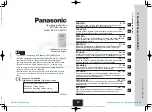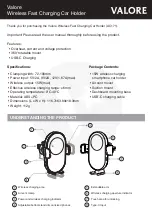
75.0084.05 20110720
Page 2 of 17
INSTALLATION
TIPS
The sensor must be
firmly fastened to
prevent vibration.
MECHANICAL
INSTALLATION-
PREPARING AND
MOUNTING THE
SENSOR
1.
Remove the screw that secures the end cap to the SuperScan extrusion (as shown in Picture 1 below).
CAUTION
: REMOVE THE MASTER AND ALL SLAVE CIRCUIT BOARDS FROM THE ALUMINUM
EXTRUSION BEFORE PERFORMING ANY DRILLING. WHEN COMPLETE, ENSURE
THAT ALL METAL SHAVINGS ARE CLEANED FROM THE EXTRUSION BEFORE
RE-INSERTING THE CIRCUIT BOARDS.
2.
Remove the plastic lens by pulling the lens out from the top of the extrusion (as shown in Picture 2 above). Do not use a
screwdriver to pry the lens, as cracking may occur.
3.
Picture #3 below shows the angle adjustment clip in its proper position within the extrusion (PCB’s are removed, and clip
is shown at end of extrusion for clarity only). To remove the clip, simply pull the tab out away and downward from the
extrusion, then rotate the module out from extrusion as shown in picture #4. To re-install, simply reverse the procedure -
the PCB must first be installed into the adjustment clip, then installed into the aluminum extrusion.
6
5
4
3
2
1
IMPORTANT NOTE:
The end of the extrusion that is towards the pivot end of a center hung door, should be in
far enough from the edge of the door, as shown in picture #5, to prevent the end cap of the
SuperScan from rubbing against the finger guard during door movement. Pay particular
attention on the safety side of the door. Hinge hung doors will not require as much
clearance between the end of the SuperScan and hinge-side jamb as shown in picture #6
below. At the leading edge of the door, the edge of the SuperScan, including the end cap,
should be as close as possible to the leading edge of the door, without creating
mechanical interference with the door jamb or with an adjacent door (pairs).
Sensor must be in a location
that does not interfere with door
hardware (finger guards, lock
rods, etc.).
The sensor must not
have any unwanted
objects likely to move or
vibrate in its path.



































